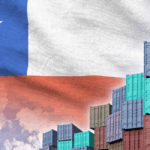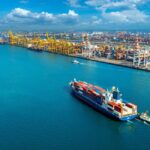Multimodal transport represents an advanced solution in the logistics sector, combining different modes of transport to optimize efficiency, reduce costs, and increase flexibility in shipments. This integrated approach allows companies to face the challenges of the global supply chain with greater agility and precision.
What does multimodal transport mean?
Multimodal transport refers to the coordinated use of two or more different modes of transport, such as road, rail, sea, or air, within a single transport contract. In other words, goods are moved from the point of origin to the final destination through different modes, but under the management of a single logistics operator, known as the Multimodal Transport Operator (MTO). This approach simplifies logistics management, as the customer interacts with a single point of contact responsible for the entire process, from planning to delivery.
A distinctive aspect of multimodal transport is the issuance of a single transport document, often referred to as the Multimodal Bill of Lading, which covers the entire shipment route. This unified document facilitates administrative and customs procedures, reducing the bureaucratic complexity associated with managing separate documents for each transport mode used.
How does multimodal transport work?
The operation of multimodal transport involves detailed planning and efficient coordination among the different transport modes involved. The process begins with an assessment of the characteristics of the goods, customer requirements, and route specifics. Subsequently, the Multimodal Transport Operator develops an optimized logistics plan that combines the most appropriate transport modes to ensure reduced transit times and competitive costs.
For example, a shipment might begin with road transport from the sender’s location to a railway terminal, continue by rail to a seaport, be loaded onto a ship for overseas transport, and finally be delivered to the final recipient via another road transport segment. Throughout this process, the MTO monitors and manages each phase, ensuring a smooth transition between different modes and resolving any logistical issues that arise.
Multimodal and intermodal transport: key differences
Although the terms “multimodal” and “intermodal” are often used interchangeably, there are key differences between the two concepts. In intermodal transport, goods remain within the same loading unit, such as a standardized container, for the entire duration of the journey, without ever being unloaded or reloaded. This method reduces the risk of damage and increases efficiency in transfer operations.
Conversely, multimodal transport allows goods to be transferred between different loading units or transport means. This provides greater flexibility in selecting shipping modes but may require additional handling operations that could affect delivery times and overall costs.
Who fills out the multimodal document required for multimodal transport?
The multimodal document is an essential element for ensuring the proper management of multimodal shipments. Its completion is the responsibility of the Multimodal Transport Operator, who oversees the entire logistics process.
Who signs the multimodal document?
The multimodal document is signed by the Multimodal Transport Operator and, in some cases, by the carriers involved in the different transport phases. This ensures that each phase of the shipment is covered by a single transport contract, simplifying administrative management and reducing the risks associated with the responsibility for goods during transit.
Dangerous goods: completing the multimodal dangerous goods declaration
When transporting dangerous goods, documentation must comply with specific regulations to ensure the safety of the entire logistics chain. The Multimodal Dangerous Goods Declaration (DGD) is essential for declaring the nature of the hazardous goods transported and the related precautions to be taken.
What does DGD (Declaration for Dangerous Goods) mean?
The DGD (Declaration for Dangerous Goods) is a mandatory document that certifies the shipment’s compliance with international regulations on the transport of hazardous goods. This document must be accurately completed, including details on the type of goods, hazard classes, safety measures, and packaging material information.
Advantages of multimodal transport
The adoption of multimodal transport offers numerous advantages to companies operating in international trade:
- Greater operational efficiency: The combination of different transport modes allows for optimized delivery times and reduced delays.
- Cost reduction: By selecting the most economical transport options and centrally managing logistics, it is possible to lower overall shipping costs.
- Increased flexibility: Multimodal transport allows adaptation to specific shipping needs, using the most suitable modes for each segment.
- Environmental sustainability: The combined use of more eco-friendly transport means, such as rail or maritime transport, helps reduce the environmental impact of logistics operations.
In conclusion, multimodal transport represents a strategic solution for companies looking to optimize their supply chain, improve operational efficiency, reduce costs, and minimize environmental impact. Adopting this approach enables businesses to address modern logistics challenges with greater flexibility and competitiveness.
If you want to discover how multimodal transport can improve your logistics operations and contribute to your company’s success, contact us today. Our team of experts is ready to provide you with personalized consulting to develop tailored solutions that meet your specific needs.










